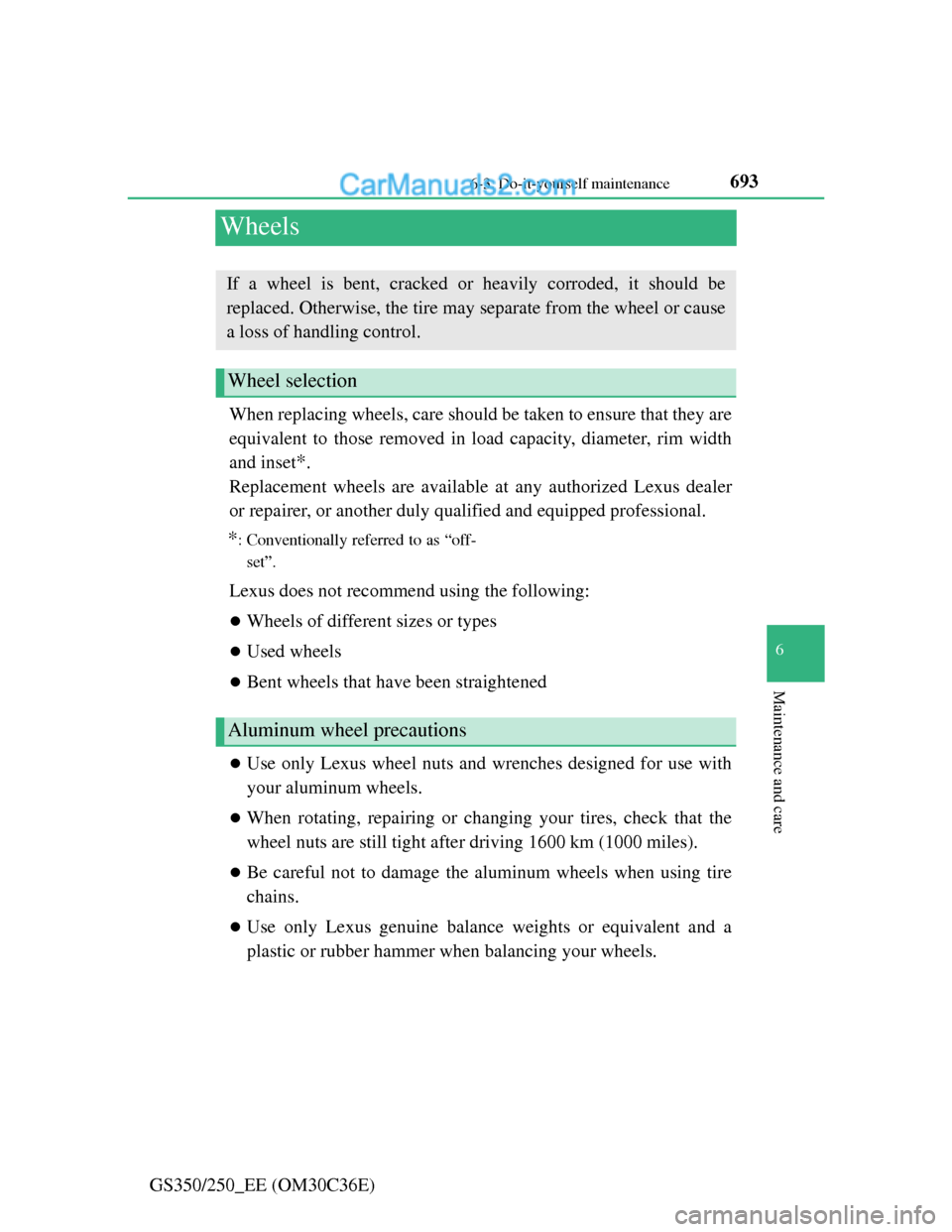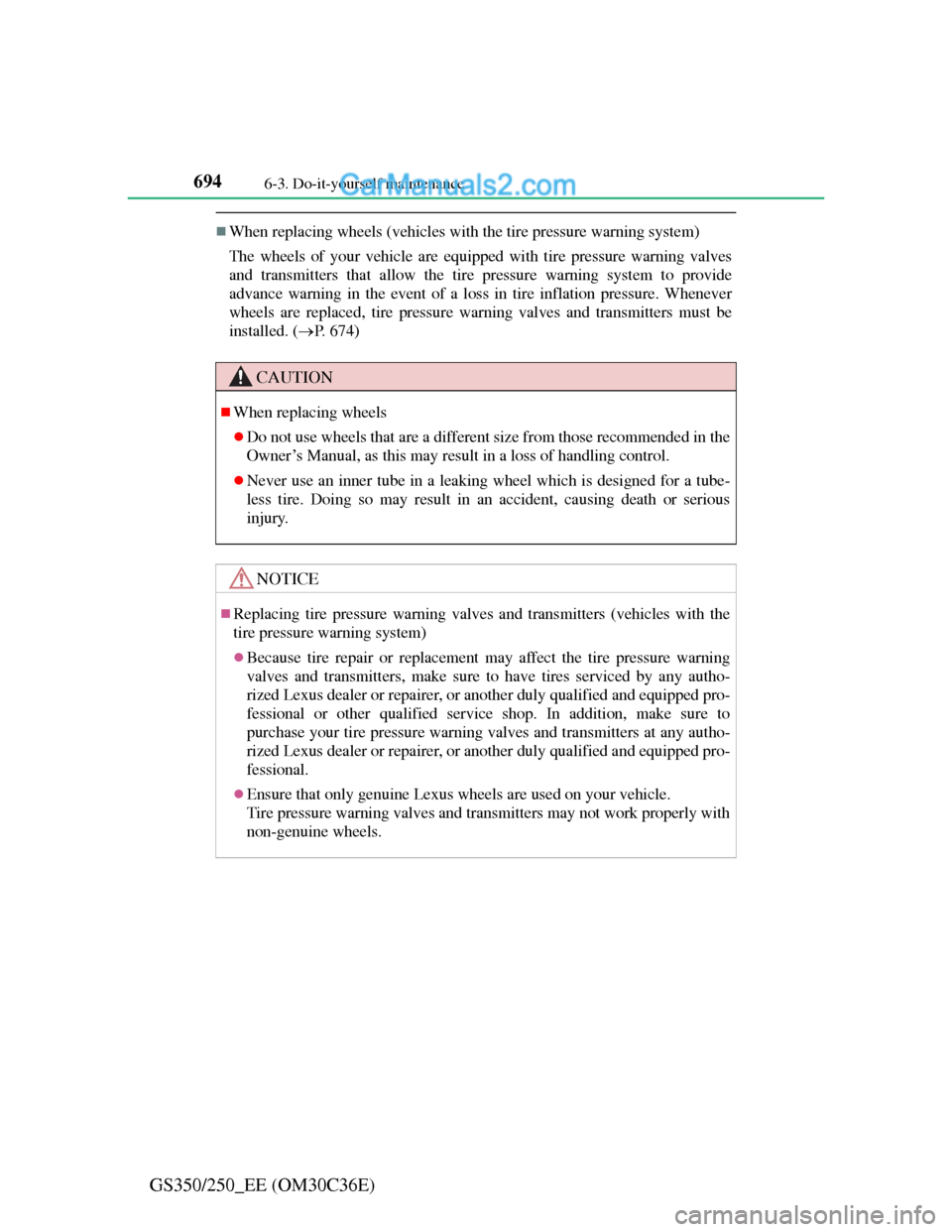Page 710 of 914
6926-3. Do-it-yourself maintenance
GS350/250_EE (OM30C36E)
CAUTION
Proper inflation is critical to save tire performance
Keep your tires properly inflated. Otherwise, the following conditions may
occur and result in an accident causing death or serious injury:
Excessive wear
Uneven wear
Poor handling
Possibility of blowouts resulting from overheated tires
Poor sealing of the tire bead
Wheel deformation and/or tire separation
A greater possibility of tire damage from road hazards
NOTICE
When inspecting and adjusting tire inflation pressure
Be sure to put the tire valve caps back on.
Without the valve caps, dirt or moisture could get into the valve and cause
air leakage, which could result in an accident. If the caps are lost, replace
them as soon as possible.
Page 711 of 914

693
6 6-3. Do-it-yourself maintenance
Maintenance and care
GS350/250_EE (OM30C36E)
Wheels
When replacing wheels, care should be taken to ensure that they are
equivalent to those removed in load capacity, diameter, rim width
and inset
*.
Replacement wheels are available at any authorized Lexus dealer
or repairer, or another duly qualified and equipped professional.
*: Conventionally referred to as “off-
set”.
Lexus does not recommend using the following:
Wheels of different sizes or types
Used wheels
Bent wheels that have been straightened
Use only Lexus wheel nuts and wrenches designed for use with
your aluminum wheels.
When rotating, repairing or changing your tires, check that the
wheel nuts are still tight after driving 1600 km (1000 miles).
Be careful not to damage the aluminum wheels when using tire
chains.
Use only Lexus genuine balance weights or equivalent and a
plastic or rubber hammer when balancing your wheels.
If a wheel is bent, cracked or heavily corroded, it should be
replaced. Otherwise, the tire may separate from the wheel or cause
a loss of handling control.
Wheel selection
Aluminum wheel precautions
Page 712 of 914

6946-3. Do-it-yourself maintenance
GS350/250_EE (OM30C36E)
When replacing wheels (vehicles with the tire pressure warning system)
The wheels of your vehicle are equipped with tire pressure warning valves
and transmitters that allow the tire pressure warning system to provide
advance warning in the event of a loss in tire inflation pressure. Whenever
wheels are replaced, tire pressure warning valves and transmitters must be
installed. (P. 674)
CAUTION
When replacing wheels
Do not use wheels that are a different size from those recommended in the
Owner’s Manual, as this may result in a loss of handling control.
Never use an inner tube in a leaking wheel which is designed for a tube-
less tire. Doing so may result in an accident, causing death or serious
injury.
NOTICE
Replacing tire pressure warning valves and transmitters (vehicles with the
tire pressure warning system)
Because tire repair or replacement may affect the tire pressure warning
valves and transmitters, make sure to have tires serviced by any autho-
rized Lexus dealer or repairer, or another duly qualified and equipped pro-
fessional or other qualified service shop. In addition, make sure to
purchase your tire pressure warning valves and transmitters at any autho-
rized Lexus dealer or repairer, or another duly qualified and equipped pro-
fessional.
Ensure that only genuine Lexus wheels are used on your vehicle.
Tire pressure warning valves and transmitters may not work properly with
non-genuine wheels.
Page 768 of 914

747
7 7-2. Steps to take in an emergency
When trouble arises
GS350/250_EE (OM30C36E)
If you think something is wrong
Fluid leaks under the vehicle.
(Water dripping from the air conditioning after use is normal.)
Flat-looking tires or uneven tire wear
Engine coolant temperature gauge needle continually points
higher than normal.
Changes in exhaust sound
Excessive tire squeal when cornering
Strange noises related to the suspension system
Pinging or other noises related to the engine
Engine missing, stumbling or running roughly
Appreciable loss of power
Vehicle pulls heavily to one side when braking
Vehicle pulls heavily to one side when driving on a level road
Loss of brake effectiveness, spongy feeling, pedal almost
touches the floor
If you notice any of the following symptoms, your vehicle proba-
bly needs adjustment or repair. Contact any authorized Lexus
dealer or repairer, or another duly qualified and equipped profes-
sional as soon as possible.
Visible symptoms
Audible symptoms
Operational symptoms
Page 777 of 914

7567-2. Steps to take in an emergency
GS350/250_EE (OM30C36E)
CAUTION
If both the ABS and the brake system warning lights remain on
Stop your vehicle in a safe place immediately and contact any authorized
Lexus dealer or repairer, or another duly qualified and equipped profes-
sional. The vehicle will become extremely unstable during braking, and the
ABS system may fail, which could cause an accident resulting in death or
serious injury.
When the electric power steering system warning light comes on
The steering wheel may become extremely heavy.
If the steering wheel becomes heavier than usual when operating, hold
firmly and operate using more force than usual.
If the tire pressure warning light comes on
Be sure to observe the following precautions. Failure to do so could cause a
loss of vehicle control and result in death or serious injury.
Stop your vehicle in a safe place as soon as possible. Adjust the tire infla-
tion pressure immediately.
If the tire pressure warning light comes on even after tire inflation pres-
sure adjustment, it is probable that you have a flat tire. Check the tires. If a
tire is flat, change it with the spare tire and have the flat tire repaired by
the nearest any authorized Lexus dealer or repairer, or another duly quali-
fied and equipped professional.
Avoid abrupt maneuvering and braking. If the vehicle tires deteriorate,
you could lose control of the steering wheel or the brakes.
If a blowout or sudden air leakage should occur
The tire pressure warning system may not activate immediately.
NOTICE
Precaution when installing a different tire
When differently constructed tires or tires of different makers, models or
tread patterns are installed, the tire pressure warning system may not oper-
ate properly.
Page 804 of 914
7837-2. Steps to take in an emergency
7
When trouble arises
GS350/250_EE (OM30C36E)
If you have a flat tire (vehicles with a spare tire)
Stop the vehicle on a hard, flat surface.
Set the parking brake.
Shift the shift lever to P.
Stop the engine.
Turn on the emergency flashers. (P. 738)
Remove the flat tire and replace it with the spare tire provided.
For details about tires: P. 672
CAUTION
If you have a flat tire
Do not continue driving with a flat tire.
Driving even a short distance with a flat tire can damage the tire and the
wheel beyond repair, which could result in an accident.
Before jacking up the vehicle
Page 807 of 914

7867-2. Steps to take in an emergency
GS350/250_EE (OM30C36E)
CAUTION
Using the tire jack
Observe the following precautions.
Improper use of the tire jack may cause the vehicle to suddenly fall off the
jack, leading to death or serious injury.
Do not use the tire jack for any purpose other than replacing tires or
installing and removing tire chains.
Only use the tire jack that comes with this vehicle for replacing a flat tire.
Do not use it on other vehicles, and do not use other tire jacks for replac-
ing tires on this vehicle.
Put the jack properly in its jack point.
Do not put any part of your body under the vehicle while it is supported
by the jack.
Do not start the engine or drive the vehicle while the vehicle is supported
by the jack.
Do not raise the vehicle while someone is inside.
When raising the vehicle, do not put an object on or under the jack.
Do not raise the vehicle to a height greater than that required to replace the
tire.
Use a jack stand if it is necessary to get under the vehicle.
When lowering the vehicle, make sure that there is no-one near the vehi-
cle. If there are people nearby, warn them vocally before lowering.
Page 810 of 914
7897-2. Steps to take in an emergency
7
When trouble arises
GS350/250_EE (OM30C36E)Chock the tires.
Slightly loosen the wheel nuts
(one turn).
CAUTION
When storing the spare tire
Be careful not to catch fingers or other body parts between the spare tire
and the body of the vehicle.
Replacing a flat tire
1
Flat tireWheel chock positions
FrontLeft-hand sideBehind the rear right-hand side tire
Right-hand sideBehind the rear left-hand side tire
RearLeft-hand sideIn front of the front right-hand side tire
Right-hand sideIn front of the front left-hand side tire
2